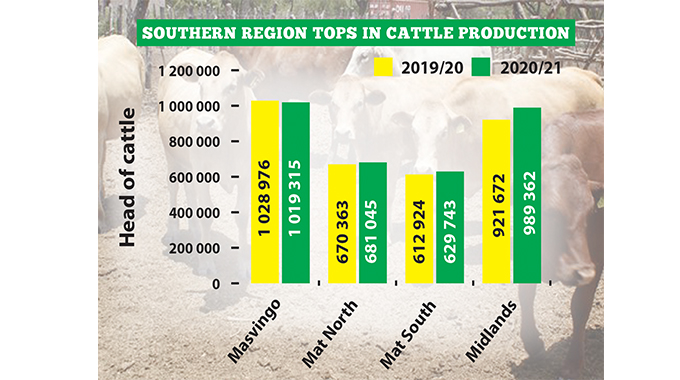
Mashudu Netsianda, Senior Reporter
THE southern region has maintained dominance in cattle production in the country with the Midlands and Matabeleland provinces recording the highest growth in numbers during the 2020/2021 season.
According to the latest Crop and Livestock Assessment report issued by the Ministry of Lands, Agriculture, Fisheries, Water and Rural Resettlement, the national cattle herd increased to close to 5,5 million.
The increase is attributed to the Government’s enhanced animal disease control measures, which have reduced livestock, especially tickborne diseases and poverty deaths, improved breeding methods, improved pastures and feed due to early rains received in the just-ended season.
Despite a drop of 9 661 from 1 028 976, Masvingo has the largest herd of 1 019 315 cattle.
The Midlands has the highest increase of 989 362 in 2020/21 from 921 672 in the 2019/20 production season.
Matabeleland South is next with an increase from 612 924 in 2019 to 629 743 in 2020.
Matabeleland North recorded an increase to 681 045 from 670 363, while Manicaland has increased its herd from 607 990 to 615 190, Mashonaland East from 567 616 to 572 154. Mashonaland West moved from 443 682 to 450 504, while Mashonaland Central suffered a decline from 590 547 to 521 335.
The increase in national cattle herd has defied the severe drought experienced in the previous season which resulted in a nine percent spike in average national cattle mortality rate from five percent in 2019.
Going forwards the country’s cattle herd is set to rise to six million by 2025 following the launch of the Livestock Growth Plan (2020-2025) by President Mnangagwa last year.
The report states that the grazing condition is fair to good across all provinces except for some parts of Gokwe North, Zambezi Valley, Nkayi and Gwanda.

“Available grazing is expected to last up to the next season in most districts. However, in the northern parts of the country specifically parts of Gokwe North, Zambezi valley, Nkayi and Gwanda are likely to have grazing challenges.
“Generally, communal areas will have shortage of grazing due to over-stocking and generally poor quality,” read the report.
The poor quality of pasture is due to invaders species, bush encroachment, veld degradation and poor grass regrowth (zero reseeding).
The Livestock Growth Plan is expected to give sustainable solutions to challenges faced by farmers and ranchers through support from the Government, the private sector and development partners.
The interventions followed realisation that growth of the livestock farming sector was stagnating amid numerous bottlenecks. It is part of the Agriculture and Food Systems Transformation Strategy set to turn agriculture into an US$8,2 billion industry by 2025 and contribute towards the achievement of Vision 2030.
According to the report, water for livestock is available in most districts. However, there are some wards in Tsholotsho, Chiredzi, Bulilima, Mt Darwin, Mutoko, Buhera, Bubi, Umguza, Chikomba, Sanyati and Binga that are likely to experience water challenges after three months as livestock will begin to move long distances to perennial water sources such as dams, boreholes and perennial rivers.
Most of the rivers and water bodies are heavily silted across all provinces. The national average calving rates remain very low ranging from 39 percent in 2020 to 41 percent in 2019 against a national target of above 60 percent.
The low calving rates are attributed to poor nutrition and poor-quality bulls.
Penning also presents challenges for breeding to those farmers who do not own bulls in the smallholder sector while, multiple use of cows as draft power affects conception, says the report.
Calf mortality across provinces ranges from 27 percent to 29 percent, which is against the recommended two percent. Poor calf management, predation, housing and nutrition and human competing with calf for milk are some of the reasons.
Diseases remain the major cause of cattle mortalities followed by drought-related deaths accounting for 69 percent and 21 percent respectively.
Meanwhile, the national average beef cattle off-take was six percent in 2019 and increased to nine percent in 2020.
“The increase in off-take was attributed to drought-induced sales and slaughters in order to mitigate against losses and also to get money for supplementary feeding, socio-economic factors such as school fees hikes and cattle sold in hard currency. Also, there were partners who advocated for value addition, encouraging farmers to pen feed,” read the report.
According to the Livestock Growth Plan, beef production is expected to grow from 50 000 tonnes to 90 000 tonnes, milk production from 79,9 million to 150 million litres, while the dairy herd will grow from 38 000 to 60 000. — @mashnets.
